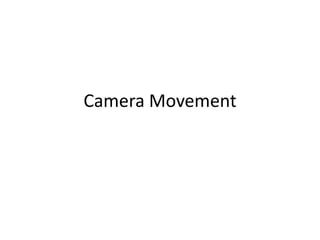
Camera Movement
- 2. Basic Movement • Pan • Tilt • Spin • Zoom • Tracking (Dolly, Trucking, Pedestal) • Rack Focus • Crane/Aerial
- 3. Pan • Camera is stationary but is moved from side to side on a horizontal plane • Commonly Used for… – Establishing shots of locations
- 4. Tilt • Camera is stationary but tilts up and down on a vertical plane • Commonly used for: – Introducing a character, particularly to show power/wealth
- 5. Spin • A stationary camera rotates 360 degrees on the z-axis • Used for (it’s not that common): – Shows disorientation, odd perspectives
- 6. Zoom • The camera doesn’t move, but the use of a zoom lens gives the illusion of motion, getting closer to the subject. • Commonly used for: – Drawing focus on an important person/object (Try to avoid using zoom where possible unless there’s a VERY good reason to do so.)
- 7. Tracking • A tracking camera follows a line of action. It is usually made up of Dolly (camera moves forwards and backwards), Pedestal (Camera moves up and down) and Trucking (camera moves side to side) movement. Sometimes, it can be done on a jib, track or handheld with a steadicam. • Commonly used for: – Revealing details through POV
- 8. Rack Focus • Like zoom, this gives the illusion of movement. Focus is ‘pulled’ from one subject to another. • Commonly used for: – Dialogue. In ‘Two Shots’ where one character is in the foreground and one is in the background, focus is pulled between them. One is blurry, the other is in focus and vice versa.
- 9. Crane/Aerial • The camera is mounted very high up; movement varies between tilts, pans and tracking. • Commonly used for: – Birds Eye Views of large events (battles etc.)
- 10. TASK • Watch the clip and make a note of all the camera movement within. • Take a camera and and film short sequences which include one of the camera movements that you recorded.
Editor's Notes
- A variant is the ‘whip pan’ where the movement is very quick, usually to draw attention to a particular person or object of interest with energy.
- A famous example is in ‘2001: A Space Odyssey’ (1968) where the lack of gravity creates a disorientation which is hard to capture on film – thus the spin.
- There’s a particular kind of zoom called a ‘Crash Zoom’ usually used in special effects shot, but sometimes to show extreme detail like in the opening of Shaun of the Dead.
- Some tracking shots are extremely complex. The opening to ‘Touch of Evil’ (1958) is very complex but draws the viewer in. In Goodfellas (1990) the tracking shot is used to show how Lorraine is drawn in to Tommy’s world as he shows her the club. Another use is in Avengers Assemble (2012) where it’s used to show how all the superheroes are now able to work together.
- In the ‘Shawshank Redemption’ (1994), an aerial shot is used to establish the setting of the prison, and it shows the order and chaos of the location in a single shot.